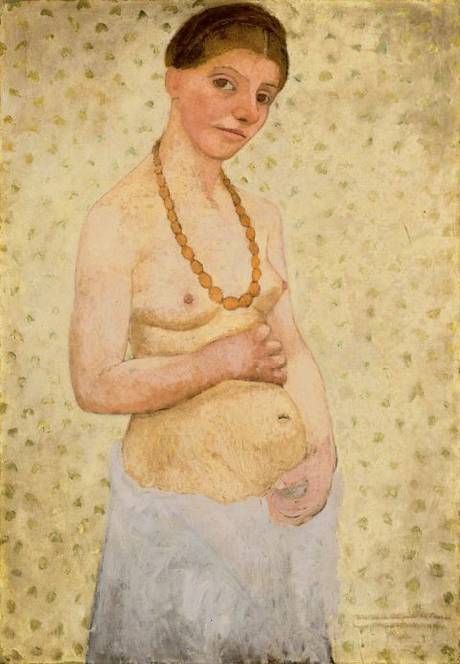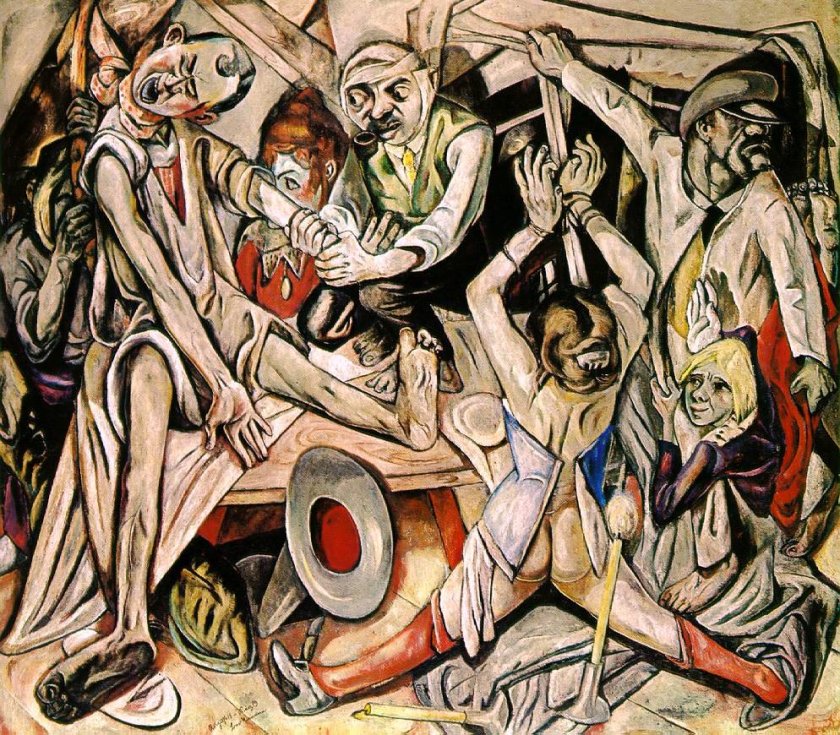
by Paula Modersohn-Becker (1906)
My blog today concludes my look at the life of the German Expressionist painter, Paula Becker, later to become Paula Modersohn-Becker. For her early life you should first read my last blog.
As I told you in that last blog, Paula moved to Worpswede and joined the other artists in 1898. The artist colony provided her with a lot of inspiration. She was influenced by resident artists such as Heinrich Vogeler, whose house, the Barkenhoff, was the centre of the artistic community. She became great friends with the young sculptor Clara Westhoff and the poet Rainer Rilke, who in 1901 would marry Clara. She also struck up a friendship with the young German painter Otto Modersohn and his wife Helene. Otto and Helene Schröder had married in 1897 and their daughter Elsbeth was born the following year.
Paula quickly found her own artistic style, painting pictures of withdrawn farm children and elderly ladies whom she painted in poorhouses (see previous blog). Paula from the outset had loved the peace and tranquillity at Worpswede but being still young, for remember, she was only twenty-two when she arrived at the artist colony, she still hankered after the excitement of city life. So after more than twelve months at Worpswede she decided to head for the then art capital of the world – Paris. She left Germany on December 31st 1899, the last day of the nineteenth century. After settling in Paris she wrote a letter to her mother, in which she commented about the change of scene:
“…I see these Paris trips as a positive addition to the slightly one-sided life I lead here……………After 10 quiet months in Worpswede, I feel that immersing myself in a foreign city with all of its stimuli is something really essential for my life…”

Paula was not alone in Paris as her friend, the sculptor from Worpswede, Clara Westhoff, had moved there the previous year hoping to study under August Rodin. At first, life in Paris was difficult for Paula. She lived in a small cramped attic room but she still embraced life in Paris with great enthusiasm and was determined to avail herself of an education in the arts, a thing which was still denied to women in Germany at the time. Whilst in the French capital, Paula Becker studied at both the Académie Colarossi and the École des Beaux-Arts, and made numerous visits to the Louvre, all the time taking pleasure in absorbing the artistic life of the city. Through her friend Clara, she met and got to know sculptor Auguste Rodin. She made many visits to contemporary exhibitions and was deeply impressed by the works of the Post-Impressionists especially Paul Cézanne, Vincent van Gogh and Paul Gauguin. She was also influenced by the strong colours used by the Fauve artists and the Realism style of Jean-François Millet.

From April to November of 1900, Paris hosted a World Fair, known as the Exposition Universelle. The reason for this great event was to celebrate the achievements of the past century and to accelerate development into the next. Paula invited Otto Modersohn, who was still at Worpswede, to come with his wife and daughter and see the great exposition. Otto Modersohn arrived in Paris in June along with another Worpswede artist, Fritz Overbeck, but he had had to leave his wife behind as she was unwell, suffering from tuberculosis. Tragically she died whilst her husband was still in Paris. He immediately returned to Worpswede to look after his one year old daughter. Paula also returned to Worpswede and during the following year she and Otto Modersohn married and Paula became stepmother to his daughter, Elsbeth.
Paula could not settle back in Worpswede and was determined that she would have to return to Paris if she was to become a serious painter. Her husband was very unhappy with her decision to leave him despite her promising to return to Worpswede on frequent visits. So although married, she abandoned her husband, despite his protestations, and returned to Paris. On arriving in Paris she recorded her thoughts about what the future held for her:
“…Now I have left Otto Modersohn, I stand between my old life and my new one. What will happen in my new life? And how shall I develop in my new life? Everything must happen now…”
These long periods living away from Otto put pressure on their marriage and after a few years the marriage was all but over and they continued to live separate lives. In 1907 she returned to Otto in Worpswede and it appeared that the two had reconciled. Paula became pregnant and bore a child, a daughter Mathilde. Mathilde (Tillie) Modersohn was born on November 2nd 1907. Otto and Paula were delighted with their new arrival but their joy was short lived as less than three weeks later, on November 20th 2007, Paula Modersohn-Becker died from a post-natal embolism. She was just thirty-one years of age. Sadly, that same month Paula’s mother died of a heart attack.
My Daily Art Display’s featured painting today is one Paula completed in Paris in May 1906. It is entitled Self Portrait on her Sixth Wedding Anniversary. It is an unusual study as one needs to remember that at the time she painted this picture, she was not pregnant. On the contrary, she had been reported as saying that, at that time in her life, she was not ready to have children and certainly not a child with Otto! So why did she depict herself “with child”? I do not know the answer to that but I read one article the other day in which the author states:
“….Paula was not pregnant in this painting. The painting, then, is a metaphor for how she felt about herself as a young artist: fecund, ripe, able for the first time in her life to create and paint freely in the manner that she wished. What she is about to give birth to is not a child but her mature, independent, artistic self…”
I will let you make your own mind up as to why she would want to depict herself as being pregnant.
In the painting, she has portrayed herself with the distended stomach of a pregnant woman but her breasts are small and pert and lack the fullness one associates with pregnancy. It is a life-size portrayal, measuring 101cms x 70cms. She stands before us, naked to the waist. Her eyes are level with ours. She stares out at us with her large brown eyes. Her auburn hair is parted in the centre and swept up into a chignon. She half smiles. Her expression is one of self-confidence. She appears unabashed by her nakedness as she tilts her head to one side in a questioning gesture. Her only clothing is a white cloth skirt which is loosely tied around her hips below her distended belly. Her large hands lie above and below her belly. It is as if she is framing and showcasing her pregnancy. Around her neck, and lying between her breasts, is a necklace made up of lozenge-shaped amber coloured beads, which subtly glow against her pale skin.
There is a Gauginesque Tahitian look about the painting. It is an unusual and a complex self portrait which she painted on the occasion of her sixth wedding anniversary to Otto Modersohn and we know that, at this time, their marriage was well and truly on the rocks and maybe that is why she signed the painting “PB” for Paula Becker, her maiden name and left out “Modersohn” her married name.
Almost a year after her death, Rainer Maria Rilke, the poet and husband of her friend Clara Westhoff wrote the poem Requiem for a Friend in memory of Paula. The poem itself is too long to add to this blog but I have attached the website URL below if you would like to read the full translation of this very moving poem.
http://www.paratheatrical.com/requiemtext.html
Her daughter Tillie, who died in 1998, aged 91, founded the Paula Modersohn-Becker-Foundation (Paula Modersohn-Becker-Stiftung) in 1978. The Paula-Modersohn-Becker Museum in Bremen has the distinction of being the first museum devoted to the work of a female painter. Early in the 20th century, the patron and merchant Ludwig Roselius amassed a collection of the artist’s major works and this along with works from the Paula Modersohn-Becker Foundation bear out her importance as a pioneer of modern painting.

In 1988 a stamp with the portrait of Paula Modersohn-Becker was issued in the series Women in German History by the German



